Abstract
1. The receptors mediating the vasodilator responses to adenosine in the isolated mesenteric arterial bed of the rat were identified by use of selective agonists and antagonists and the involvement of the endothelium was examined. 2. Adenosine-mediated dilatation of the mesentery was potentiated by the nitric oxide synthase inhibitor, NG-nitro-L-arginine methyl ester (L-NAME, 100 microM), but in contrast, removal of the endothelium substantially reduced the responses to adenosine. 3. The order of potency of adenosine receptor agonists was: 5'-N-ethylcarboxamidoadenosine (NECA) > 2-p-(-2-carboxyethyl)phenethylamino-5'-N-ethylcarboxamidoadenosine (CGS 21680) > 2-chloro-N6-cyclopentyl-adenosine (CCPA) > or = adenosine, suggesting the presence of A2A receptors. 4. Adenosine-mediated dilatation was inhibited by the non-selective adenosine receptor antagonist, 8-phenyltheophylline (3 microM) and by the A2A receptor antagonist 8-(3-chlorostyryl)caffeine (500 nM), but was unaffected by the A1 receptor antagonist, 1,3-dipropyl-8-cyclopentylxanthine (DPCPX; 10 nM). 5. Reducing the pH of the perfusate to 6.8 potentiated the actions of both CGS 21680 and adenosine, but the vasodilator effects of carbachol were the same at both pH values. The adenosine response at the lower pH as at pH 7.4, was unaffected by DPCPX. The actions of the nitrovasodilator, sodium nitroprusside, were also potentiated at pH 6.8 relative to those at the higher pH value but smaller responses were obtained at the lower pH value with forskolin, a stimulator of adenylyl cyclase, than at pH 7.4. 6. It is concluded that the adenosine receptor mediating dilatation of the rat mesenteric arterial bed is of the A2A subtype, that the response, under the conditions used, is apparently partly dependent on the endothelium (but not due to the release of nitric oxide), and that the response to activation of this receptor is potentiated by a reduction in pH which is similar to that seen in ischaemic conditions.
Full text
PDF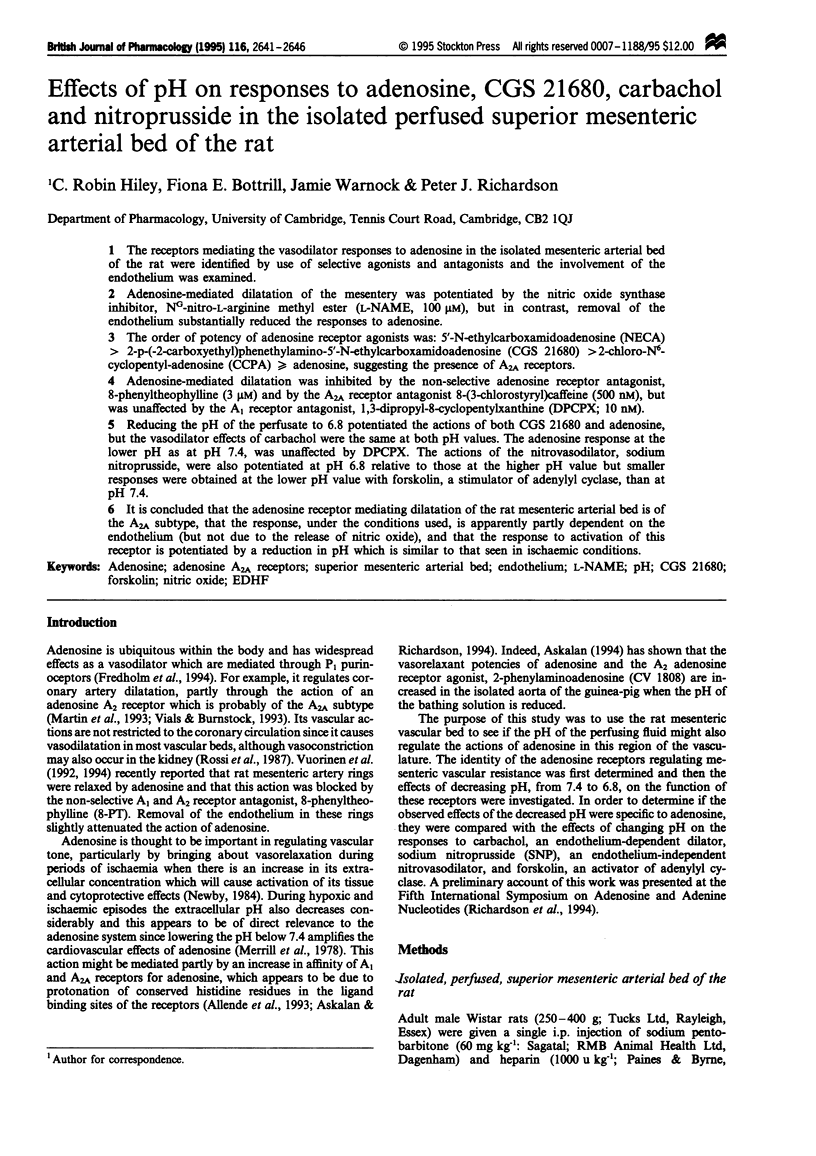
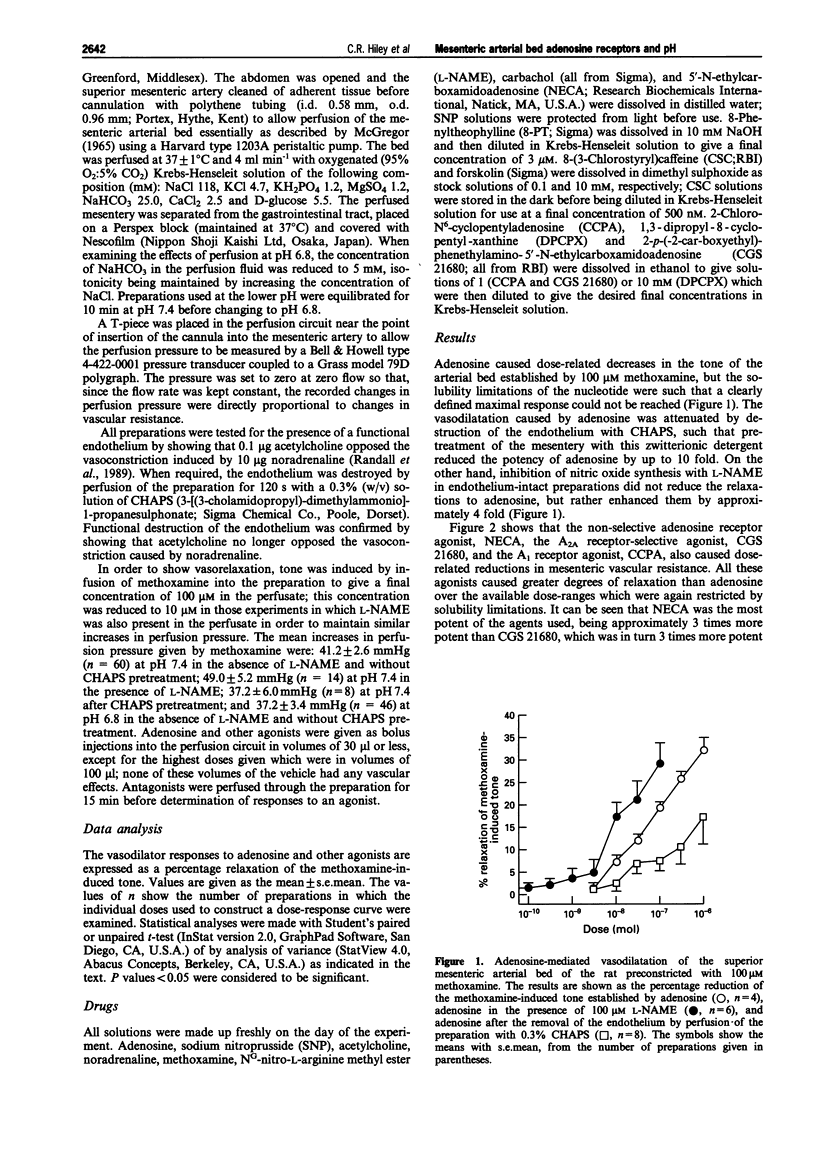
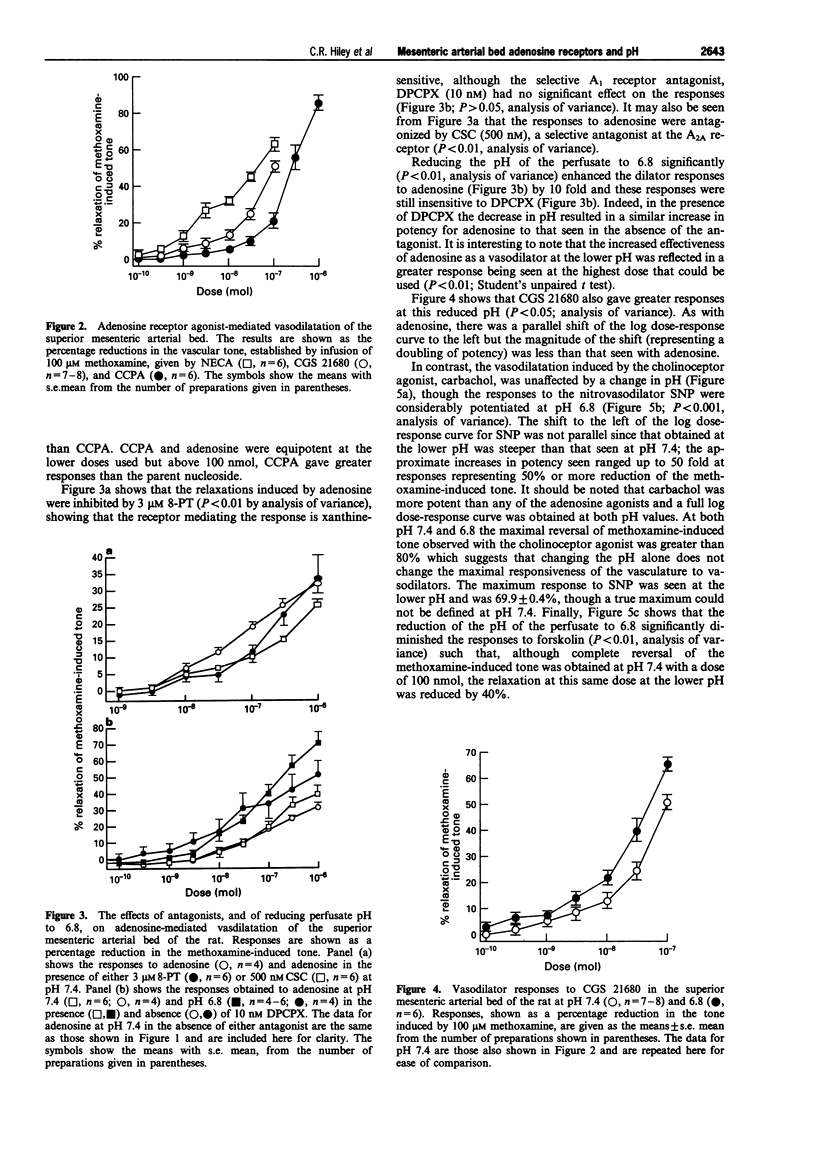
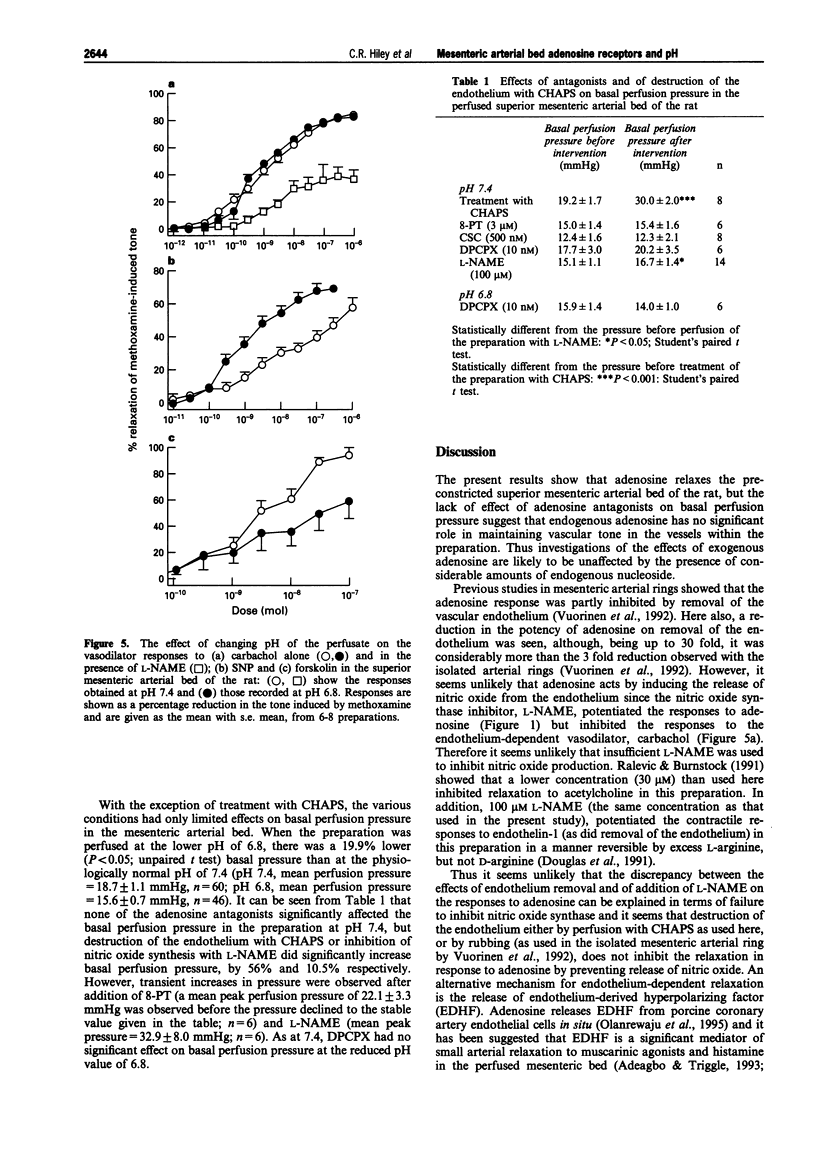
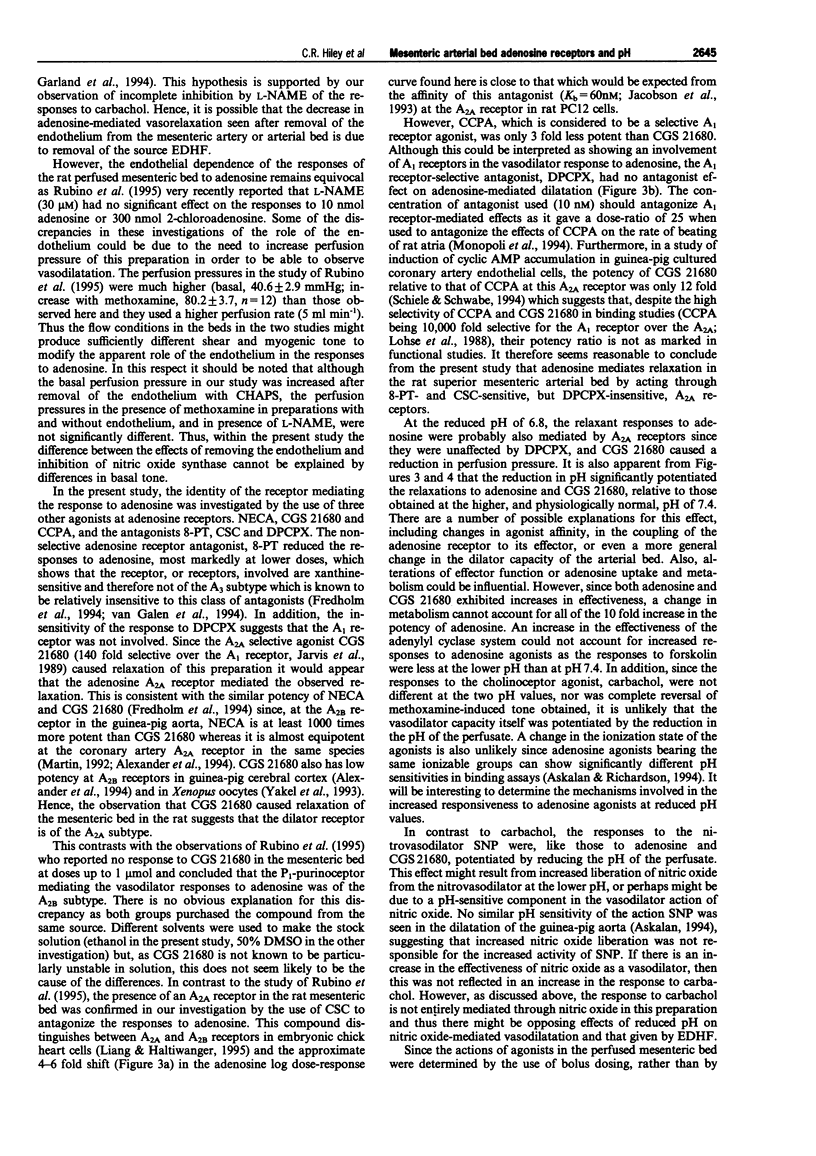
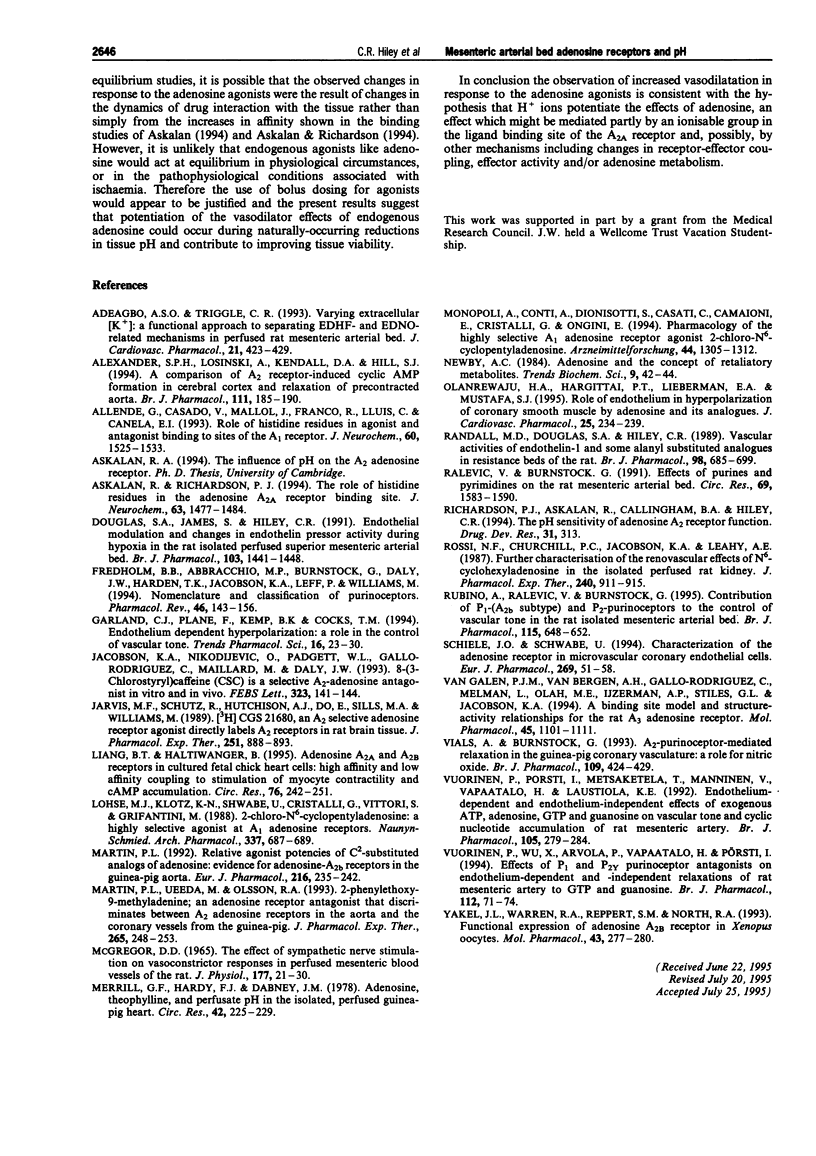
Selected References
These references are in PubMed. This may not be the complete list of references from this article.
- Adeagbo A. S., Triggle C. R. Varying extracellular [K+]: a functional approach to separating EDHF- and EDNO-related mechanisms in perfused rat mesenteric arterial bed. J Cardiovasc Pharmacol. 1993 Mar;21(3):423–429. [PubMed] [Google Scholar]
- Alexander S. P., Losinski A., Kendall D. A., Hill S. J. A comparison of A2 adenosine receptor-induced cyclic AMP generation in cerebral cortex and relaxation of pre-contracted aorta. Br J Pharmacol. 1994 Jan;111(1):185–190. doi: 10.1111/j.1476-5381.1994.tb14042.x. [DOI] [PMC free article] [PubMed] [Google Scholar]
- Allende G., Casadó V., Mallol J., Franco R., Lluis C., Canela E. I. Role of histidine residues in agonist and antagonist binding sites of A1 adenosine receptor. J Neurochem. 1993 Apr;60(4):1525–1533. doi: 10.1111/j.1471-4159.1993.tb03317.x. [DOI] [PubMed] [Google Scholar]
- Askalan R., Richardson P. J. Role of histidine residues in the adenosine A2a receptor ligand binding site. J Neurochem. 1994 Oct;63(4):1477–1484. doi: 10.1046/j.1471-4159.1994.63041477.x. [DOI] [PubMed] [Google Scholar]
- Douglas S. A., James S., Hiley C. R. Endothelial modulation and changes in endothelin pressor activity during hypoxia in the rat isolated perfused superior mesenteric arterial bed. Br J Pharmacol. 1991 Jun;103(2):1441–1448. doi: 10.1111/j.1476-5381.1991.tb09808.x. [DOI] [PMC free article] [PubMed] [Google Scholar]
- Fredholm B. B., Abbracchio M. P., Burnstock G., Daly J. W., Harden T. K., Jacobson K. A., Leff P., Williams M. Nomenclature and classification of purinoceptors. Pharmacol Rev. 1994 Jun;46(2):143–156. [PMC free article] [PubMed] [Google Scholar]
- Garland C. J., Plane F., Kemp B. K., Cocks T. M. Endothelium-dependent hyperpolarization: a role in the control of vascular tone. Trends Pharmacol Sci. 1995 Jan;16(1):23–30. doi: 10.1016/s0165-6147(00)88969-5. [DOI] [PubMed] [Google Scholar]
- Jacobson K. A., Nikodijević O., Padgett W. L., Gallo-Rodriguez C., Maillard M., Daly J. W. 8-(3-Chlorostyryl)caffeine (CSC) is a selective A2-adenosine antagonist in vitro and in vivo. FEBS Lett. 1993 May 24;323(1-2):141–144. doi: 10.1016/0014-5793(93)81466-d. [DOI] [PMC free article] [PubMed] [Google Scholar]
- Jarvis M. F., Schulz R., Hutchison A. J., Do U. H., Sills M. A., Williams M. [3H]CGS 21680, a selective A2 adenosine receptor agonist directly labels A2 receptors in rat brain. J Pharmacol Exp Ther. 1989 Dec;251(3):888–893. [PubMed] [Google Scholar]
- Liang B. T., Haltiwanger B. Adenosine A2a and A2b receptors in cultured fetal chick heart cells. High- and low-affinity coupling to stimulation of myocyte contractility and cAMP accumulation. Circ Res. 1995 Feb;76(2):242–251. doi: 10.1161/01.res.76.2.242. [DOI] [PubMed] [Google Scholar]
- Lohse M. J., Klotz K. N., Schwabe U., Cristalli G., Vittori S., Grifantini M. 2-Chloro-N6-cyclopentyladenosine: a highly selective agonist at A1 adenosine receptors. Naunyn Schmiedebergs Arch Pharmacol. 1988 Jun;337(6):687–689. doi: 10.1007/BF00175797. [DOI] [PubMed] [Google Scholar]
- MCGREGOR D. D. THE EFFECT OF SYMPATHETIC NERVE STIMULATION OF VASOCONSTRICTOR RESPONSES IN PERFUSED MESENTERIC BLOOD VESSELS OF THE RAT. J Physiol. 1965 Mar;177:21–30. doi: 10.1113/jphysiol.1965.sp007572. [DOI] [PMC free article] [PubMed] [Google Scholar]
- Martin P. L. Relative agonist potencies of C2-substituted analogues of adenosine: evidence for adenosine A2B receptors in the guinea pig aorta. Eur J Pharmacol. 1992 Jun 5;216(2):235–242. doi: 10.1016/0014-2999(92)90365-b. [DOI] [PubMed] [Google Scholar]
- Martin P. L., Ueeda M., Olsson R. A. 2-Phenylethoxy-9-methyladenine: an adenosine receptor antagonist that discriminates between A2 adenosine receptors in the aorta and the coronary vessels from the guinea pig. J Pharmacol Exp Ther. 1993 Apr;265(1):248–253. [PubMed] [Google Scholar]
- Merrill G. F., Haddy F. J., Dabney J. M. Adenosine, theophylline, and perfusate pH in the isolated, perfused guinea pig heart. Circ Res. 1978 Feb;42(2):225–229. doi: 10.1161/01.res.42.2.225. [DOI] [PubMed] [Google Scholar]
- Monopoli A., Conti A., Dionisotti S., Casati C., Camaioni E., Cristalli G., Ongini E. Pharmacology of the highly selective A1 adenosine receptor agonist 2-chloro-N6-cyclopentyladenosine. Arzneimittelforschung. 1994 Dec;44(12):1305–1312. [PubMed] [Google Scholar]
- Olanrewaju H. A., Hargittai P. T., Lieberman E. A., Mustafa S. J. Role of endothelium in hyperpolarization of coronary smooth muscle by adenosine and its analogues. J Cardiovasc Pharmacol. 1995 Feb;25(2):234–239. doi: 10.1097/00005344-199502000-00008. [DOI] [PubMed] [Google Scholar]
- Ralevic V., Burnstock G. Effects of purines and pyrimidines on the rat mesenteric arterial bed. Circ Res. 1991 Dec;69(6):1583–1590. doi: 10.1161/01.res.69.6.1583. [DOI] [PubMed] [Google Scholar]
- Randall M. D., Douglas S. A., Hiley C. R. Vascular activities of endothelin-1 and some alanyl substituted analogues in resistance beds of the rat. Br J Pharmacol. 1989 Oct;98(2):685–699. doi: 10.1111/j.1476-5381.1989.tb12644.x. [DOI] [PMC free article] [PubMed] [Google Scholar]
- Rossi N. F., Churchill P. C., Jacobson K. A., Leahy A. E. Further characterization of the renovascular effects of N6-cyclohexyladenosine in the isolated perfused rat kidney. J Pharmacol Exp Ther. 1987 Mar;240(3):911–915. [PMC free article] [PubMed] [Google Scholar]
- Rubino A., Ralevic V., Burnstock G. Contribution of P1-(A2b subtype) and P2-purinoceptors to the control of vascular tone in the rat isolated mesenteric arterial bed. Br J Pharmacol. 1995 Jun;115(4):648–652. doi: 10.1111/j.1476-5381.1995.tb14981.x. [DOI] [PMC free article] [PubMed] [Google Scholar]
- Schiele J. O., Schwabe U. Characterization of the adenosine receptor in microvascular coronary endothelial cells. Eur J Pharmacol. 1994 Sep 15;269(1):51–58. doi: 10.1016/0922-4106(94)90025-6. [DOI] [PubMed] [Google Scholar]
- Vials A., Burnstock G. A2-purinoceptor-mediated relaxation in the guinea-pig coronary vasculature: a role for nitric oxide. Br J Pharmacol. 1993 Jun;109(2):424–429. doi: 10.1111/j.1476-5381.1993.tb13586.x. [DOI] [PMC free article] [PubMed] [Google Scholar]
- Vuorinen P., Pörsti I., Metsä-Ketelä T., Manninen V., Vapaatalo H., Laustiola K. E. Endothelium-dependent and -independent effects of exogenous ATP, adenosine, GTP and guanosine on vascular tone and cyclic nucleotide accumulation of rat mesenteric artery. Br J Pharmacol. 1992 Feb;105(2):279–284. doi: 10.1111/j.1476-5381.1992.tb14246.x. [DOI] [PMC free article] [PubMed] [Google Scholar]
- Vuorinen P., Wu X., Arvola P., Vapaatalo H., Pörsti I. Effects of P1 and P2Y purinoceptor antagonists on endothelium-dependent and -independent relaxations of rat mesenteric artery to GTP and guanosine. Br J Pharmacol. 1994 May;112(1):71–74. doi: 10.1111/j.1476-5381.1994.tb13031.x. [DOI] [PMC free article] [PubMed] [Google Scholar]
- Yakel J. L., Warren R. A., Reppert S. M., North R. A. Functional expression of adenosine A2b receptor in Xenopus oocytes. Mol Pharmacol. 1993 Feb;43(2):277–280. [PubMed] [Google Scholar]
- van Galen P. J., van Bergen A. H., Gallo-Rodriguez C., Melman N., Olah M. E., IJzerman A. P., Stiles G. L., Jacobson K. A. A binding site model and structure-activity relationships for the rat A3 adenosine receptor. Mol Pharmacol. 1994 Jun;45(6):1101–1111. [PMC free article] [PubMed] [Google Scholar]


